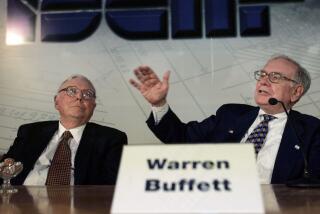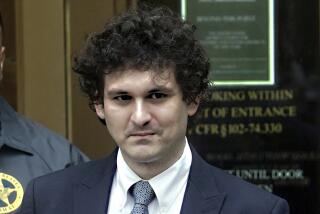Dynasty, American-Style : THE HOUSE OF MORGAN: An American Banking Dynasty and the Rise of Modern Finance <i> by Ron Chernow (Atlantic Monthly Press/A Morgan Entrekin Book: $29.95; 812 pp.; 0-87113-3385) </i>
- Share via
Bankers have never been popular and are often blamed for everything. In the last century, several states actually banned bankers, the way they might outlaw nude dancers or firecracker salesmen today. Texas didn’t lift its ban on bankers until 1904. (Note: Given the number of bank and S&L; fraud cases currently pending, perhaps Texas should reconsider.)
For their part, bankers have done their best to be as secretive, aloof and uncommunicative with the general public as possible. This was certainly true of the Morgans, which explains why it’s taken so long for the remarkable history of Junius, Pierpont and Jack to come out. But come out it has--all the juicy gossip about Pierpont and his unfortunate nose, his womanizing, his campaigning to cover up nude statues, his consulting with astrologers, the stuff you’d have read in the tabloids if bankers talked.
(It seems that bankers have been far more faithful to the code of silence than the Mafia has, given the number of Mafia tell-all books that are published. The champion of bankers’ omerta , Ron Chernow tells us, is Pierpont’s pal, George Baker, of the First National, the sphinx of Wall Street, who gave no interviews between 1863 and 1923.)
Although we’re more inclined to think of the Kennedys and the Rockefellers as America’s dynastic rulers, the quieter Morgans can lay better claim to the title. Their bank propped up foreign governments, financed both world wars, ran most of the nation’s railroads, served as a private Federal Reserve, and meddled continuously in politics. Consequently, Chernow has written more than a book about a bank. It’s also as informative and entertaining a history, especially of the period from 1880-1930, as this reviewer has read.
Beginning with the 1830s, when a bond broker named George Peabody invited an enthusiastic unknown, Junius Morgan, to share in his enterprise, Chernow takes us through the fantastic developments that propelled the Morgans into great riches and made them the Protestant equivalents of the famous Rothschilds (alas, no relation to yours truly).
The business was handed soon enough from Junius to his only son, the bulbous-nosed Pierpont, who obviously inherited the money gene. Pierpont chewed on big cigars, growled yes or no answers to terrified subordinates, interpreted every story in the Bible literally, and as mentioned above, entertained a succession of ladies on his yacht. He was the model, in other words, for the perfect modern banker.
It was Pierpont who took the Morgan bank into the 20th Century, loaned out fabulous sums at home and abroad, rescued governments and corporations from bankruptcy, and had numerous run-ins with the trust-busting Teddy Roosevelt, who Chernow says was much more friend than foe. Pierpont and Teddy, enemies in the textbooks, turn out to have been “secret blood brothers” who shared deep philosophical affinities. The bitterest Morgan foe, in fact, may have been the pro-business William Howard Taft.
The Pierpont era ended with his death in 1913; the business was handed over to his only son, Jack. High-strung, defensive and openly xenophobic, Jack Morgan brought out the bank’s muted WASP prejudices, supporting Henry Ford’s campaign against “hyphenated Americans” and vilifying Germans and Jews alike. He believed that people were out to get him, which some apparently were. He survived one stabbing and a letter bomb that was returned to sender due to insufficient postage.
It was during the Jack Morgan era that Tom Lamont, a bank partner who served as a de facto secretary of state, took on the difficult task of defending two of the Morgans’ most important international clients: Mussolini and the emperor of Japan. Lamont even took to writing press releases for Il Duce in order to persuade the American public that (1) Mussolini was a nice guy; (2) the invasion of Ethiopia was a happy event, akin to America’s own push westward through the wilderness. Of Hitler, Lamont once said the only good thing about the man was his “wholesome” attitude toward Jews, and on the eve of Pearl Harbor, he blithely announced: “I may be 100 percent mistaken but I am not worried about the Far East.”
Lamont is only one example of how the Morgans became increasingly isolated from reality as the 20th Century progressed, and a reminder of why bankers probably should be restrained from conducting foreign policy.
Meanwhile, on the economic front, nowhere has our tenuous financial system been better described than by Chernow, as he recounts how the Morgan bankers face one panic or crash or crisis after another. In the crash of 1883, the panic of 1901, the crash of 1907, the emergency shutdown of the stock exchange in 1914, etc., there are many parallels to our current banking dilemmas. It’s both reassuring and unsettling to discover that the excesses of the 1980s are nothing new:
Mergers and acquisitions? There was a merger and acquisition mania in 1899.
Bank failures? Six hundred banks failed in 1893 and hundreds more in 1932.
Hostile takeovers? When the celebrated Jay Gould tried to raid a railroad owned by a Joseph Ramsey, two trainloads of henchmen representing each side collided in a dark tunnel, the survivors started shooting at one another, and the militia was called out. This is one technique Henry Kravis and the Coniston Partners haven’t tried.
Stupid loans to Latin America? In what seems to be a case of recurring amnesia, the U.S. banks make this mistake every fifth decade. It was the 1820s when the first round of Latin American loans defaulted; then, in the 1870s, more big loans produced the same result. In 1920, the banks got wise and sold Latin American bonds to thousands of small investors, who took most of the losses for that round, but in 1970, the banks once again risked their own capital to the tune of $3 billion that they’ll never see again.
Surely in 2020 these latest defaults will have been forgotten and we’ll have the next Latin American debt crisis, unless of course the bankers remember what they’ve read in this book.
Ivan Boesky, the Wall Street crook? How about Richard Whitney, no less than the president of the New York Stock Exchange in the early 1930s, whose shady dealings landed him in Sing Sing.
Public hearings to straighten out the latest investment mess? These have become a regular fact of Wall Street life. There were the 1905 hearings on abuses of life-insurance companies that squandered the policyholders’ money on fancy parties and houses of mirth. There were the 1912 Pujo hearings on banking abuses, at which Pierpont himself was forced to testify. Two decades later, Jack Morgan took the oath at the Pecora hearings, and more or less reiterated what his father had said.
(At the Pecora hearings, it was disclosed that officers at the National City Bank, just prior to declaring the institution bankrupt, lent themselves $2.4 million, interest-free, from a special “morale” fund. Is this where Drexel got the idea?)
Eventually, thanks to the Glass-Steagall Act and other restrictions on bankers, the Morgans lost their preeminence, and the firm was forced to split into Morgan Stanley, the investment house, and J. P. Morgan, the commercial house. Later, the J. P. Morgan branch merged with Guaranty Trust to form the Morgan Guaranty we have today.
All of the gentlemen’s agreements on which bankers conducted business in the early 1900s were long since abrogated, until by the 1980s, the bankers were happily cutting each other’s throats. Recently, the last taboo, “Thou shalt not mount a hostile raid against another bank,” was violated when Morgan Stanley aided the Bank of New York in its assault on Irving Trust. Pierpont, Chernow says, would have been horrified.
No doubt, today’s bankers would like us all to remember that in the not-too-distant past, their generous colleague, Pierpont, bailed out the city of New York, and also the federal government. This should make us feel a bit more sympathetic in the present crisis, when the government must return the favor and all of us must bail out the banks.
More to Read
Sign up for our Book Club newsletter
Get the latest news, events and more from the Los Angeles Times Book Club, and help us get L.A. reading and talking.
You may occasionally receive promotional content from the Los Angeles Times.










